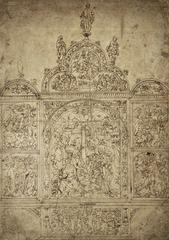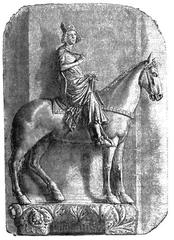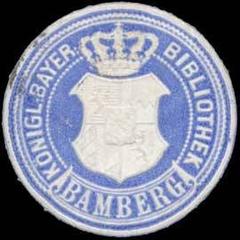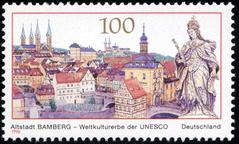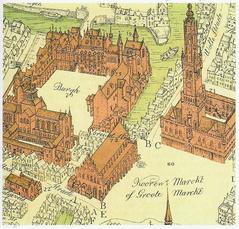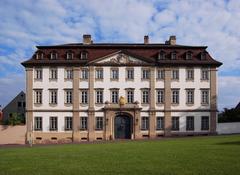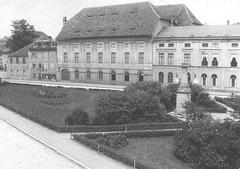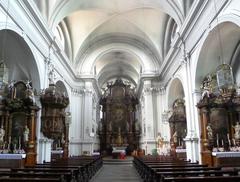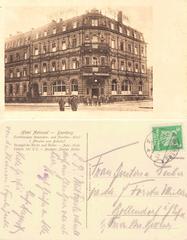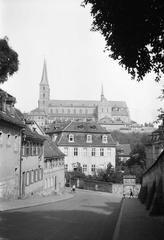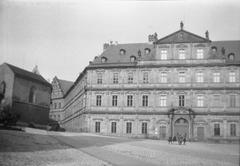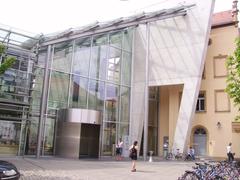Bischofspfalz Bamberg Visiting Hours, Tickets, and Historical Sites Guide
Date: 04/07/2025
Introduction: Discovering the Bischofspfalz Bamberg
Perched atop Cathedral Hill in Bamberg, Germany, the Bischofspfalz—also known as the Bishop’s Palace or Alte Hofhaltung (Old Court)—is a standout historical monument revealing the city’s deep ecclesiastical roots and imperial connections. Established soon after the Diocese of Bamberg was founded in 1007 by King Henry II, this palace served as the principal residence and administrative heart for Bamberg’s prince-bishops, figures who held both secular and ecclesiastical sway within the Holy Roman Empire. Its immediate proximity to Bamberg Cathedral highlights the intertwined nature of religious and political authority that shaped Bamberg’s medieval legacy (MyGermanCity; One Million Places).
Architecturally, the Bischofspfalz is a testament to centuries of stylistic evolution. Its Romanesque foundations, Gothic expansions, and Baroque embellishments reflect the city’s ongoing cultural and artistic development. Visitors are greeted by a Renaissance courtyard framed by half-timbered galleries, intricate stone portals like the “Schöne Pforte,” and lavish interiors that underscore Bamberg’s standing as a hub of Counter-Reformation art (Nomads Travel Guide; Happy to Wander).
As a vital part of Bamberg’s UNESCO World Heritage-listed Old Town, the Bischofspfalz offers diverse experiences: guided tours, exhibitions at the Historical Museum of Bamberg, and seasonal events in its scenic courtyards. This guide equips travelers and history lovers with everything needed for a rewarding visit—from historical context and travel tips to practical information on tickets, hours, and nearby sites (DiscoverWalks; Bamberg Tourism).
Quick Index
- Early Origins and Medieval Foundations
- Architectural Evolution
- The Prince-Bishopric’s Influence
- Transformation Over Time
- Artistic Highlights
- Visiting: Hours, Tickets & Accessibility
- Nearby Attractions
- UNESCO Heritage and Preservation
- Visitor FAQs
Historical Overview
Early Origins and Medieval Foundations
The Bischofspfalz was established as the residential and administrative core for Bamberg’s prince-bishops. Its roots reach back to the early 11th century, with King Henry II’s founding of the diocese and palace to anchor Bamberg’s role in the Holy Roman Empire (mygermancity.com; discoverwalks.com).
Architectural Evolution
Built initially in the Romanesque style, the palace expanded over centuries to incorporate Gothic and Baroque elements. These transformations mirror Bamberg’s cultural ascendancy, and the palace now features ceremonial halls, administrative offices, chapels, and residential chambers, many with panoramic views (mygermancity.com).
Role in the Prince-Bishopric
By the 13th century, Bamberg’s bishops were prince-bishops—both secular and spiritual leaders. The Bischofspfalz was the epicenter of governance, hosting synods, diplomatic negotiations, and preserving documents pivotal to the region’s history (discoverwalks.com).
Transformation and Later History
The secularization of Bamberg in 1802 marked the end of the prince-bishopric era. The Bischofspfalz transitioned to administrative and cultural functions, with parts merging into the New Residence, which became the hub of Bavarian administration (mygermancity.com).
Artistic and Architectural Highlights
Visitors to the Bischofspfalz can admire its harmonious blend of Romanesque, Gothic, and Baroque architecture. Noteworthy are the grand ceremonial halls, ornate staircases, and richly adorned chapels. The Diocesan Museum showcases medieval manuscripts, liturgical artifacts, and treasures from the cathedral (mygermancity.com).
Plan Your Visit: Hours, Tickets & Accessibility
- Visiting Hours: Typically open Tuesday to Sunday, 10:00–17:00; closed Mondays. Seasonal adjustments may apply—refer to the official website for updates.
- Tickets: Standard entry is around €7 for adults, with discounts for students, seniors, and groups. Children under 12 often enter free.
- Guided Tours: Tours in several languages offer deep insights and are best booked in advance during peak seasons.
- Accessibility: Most areas are wheelchair accessible (ramps/elevators available). Some historic sections may be less accessible—contact ahead if you have specific needs.
- Photography: Permitted in most public spaces but may be restricted in certain museum areas.
Nearby Bamberg Historical Sites
The Bischofspfalz anchors the UNESCO-listed Old Town, surrounded by:
- Bamberg Cathedral: Romanesque-Gothic marvel with imperial tombs.
- New Residence: Baroque palace with stunning rose gardens.
- Old Town Hall: Iconic building perched above the Regnitz River.
- Altenburg Castle: Offering panoramic views and medieval history (explorial.com).
Preservation & UNESCO World Heritage
Awarded UNESCO World Heritage status in 1993, the Bischofspfalz is a symbol of medieval urban planning and ongoing preservation efforts. Bamberg’s careful conservation ensures these architectural treasures remain intact for future generations (discoverwalks.com).
Visitor FAQs
Q: What are the Bischofspfalz visiting hours?
A: Generally, Tuesday to Sunday, 10:00–17:00 (closed Mondays). Always check the official site for current times.
Q: How do I buy tickets?
A: Purchase at the entrance or online—advance booking is advised for tours.
Q: Is Bischofspfalz accessible for wheelchairs?
A: Most public areas are accessible. Contact for detailed assistance.
Q: Are guided tours available?
A: Yes, in multiple languages—booking in advance is recommended.
Q: What other sites should I see nearby?
A: Cathedral, New Residence, Old Town Hall, and Altenburg Castle.
Practical Visiting Information
Location & Getting There
- Address: Domplatz 7, 96049 Bamberg, Germany
- A 20-minute walk or short bus ride from Bamberg’s main train station.
- Parking: Limited; use nearby garages and walk or cycle (ADAC).
Facilities
- Accessibility: Main courtyard is accessible; some museum areas may be limited.
- Restrooms: Modern facilities available.
- Shops: Souvenirs, books, and local crafts.
- Dining: Numerous cafés and restaurants in Domplatz (Entdecke Deutschland).
Guided Tours & Audio Guides
Tours are available in German and other languages by arrangement. Audio guides provide self-directed exploration (Medieval Histories).
What to See and Do
- Courtyard: Renaissance galleries and arcades; hosts concerts and events.
- Museum Exhibits: Medieval artifacts, art, and Bamberg’s urban history.
- Events: Classical concerts, theater, and festivals year-round (Franken Tourismus).
Tips for Visitors
- Best Time: Spring and summer for outdoor events; autumn for fewer crowds; winter for cozy museum visits and Christmas markets (Happy to Wander).
- Photography: Allowed in most areas; restrictions in some exhibits.
- Kids & Groups: Interactive exhibits and workshops available.
- Combine Visits: Walk to the Cathedral, New Residence, and Old Town Hall (Bavaria Travel).
Final Thoughts: Summary and Tips
The Bischofspfalz is a cornerstone of Bamberg’s rich cultural tapestry. Its layered architecture and ongoing community use make it both a monument to the past and a vibrant part of the city’s present. Plan your visit by checking official hours, securing tickets or tours in advance, and combining the Bischofspfalz with other historical sites in the Old Town. For extra value, download the Audiala app for guided audio tours and follow Bamberg’s tourism channels for updates and events.
Additional Resources
- MyGermanCity Bamberg
- DiscoverWalks Bamberg Guide
- ExploreCity Life Bamberg
- MapCarta Bamberg Cathedral Hill
For further details, virtual tours, and interactive maps, consult the official Bamberg tourism website and the other resources listed below.
Sources
- DiscoverWalks Bamberg Guide
- MyGermanCity Bamberg
- Explorial Bamberg Altstadt
- Nomads Travel Guide Bamberg
- Happy to Wander Bamberg Guide
- One Million Places Bamberg Sights
- UNESCO World Heritage Bamberg
- Franken Tourismus Bamberg
- PlanetWare Bamberg Attractions
- Bamberg Tourism Official Site

